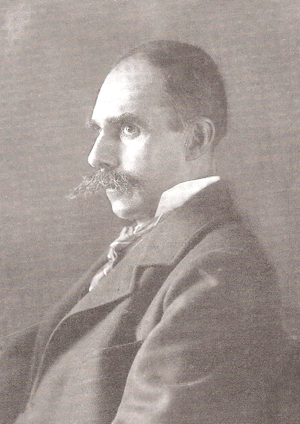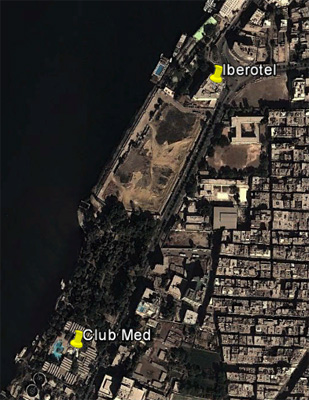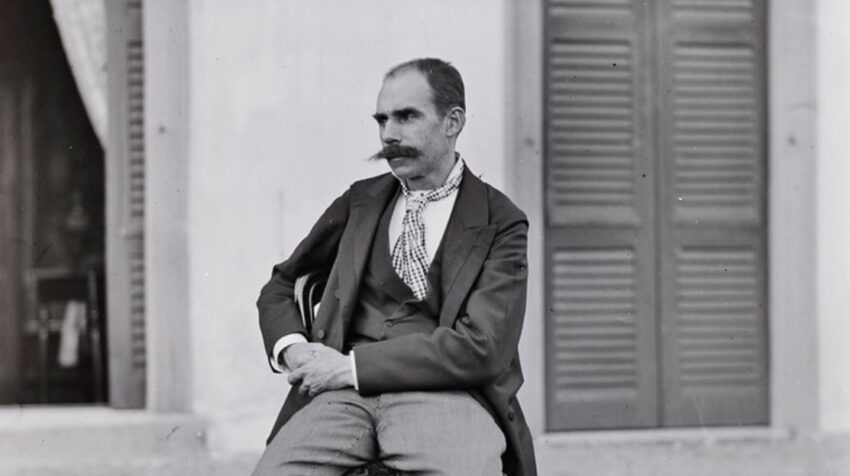In the 19th century, if you were well-to-do and suffering from lung disease such as tuberculosis, your best option was to reside in the agreeable dry climate of Egypt. Lady Lucie Duff Gordon (the 19th century authoress, not to be confused with the 20th century fashion designer and Titanic survivor) was among those who traded damp England for more exotic surroundings. Spending the last part of her life in a house in Luxor (on top of the unexcavated temple of Luxor itself), she became a valued member of Egyptian high society. As late as 1901, George Herbert (5th Earl of Carnarvon), went to recover in Egypt after a severe motoring accident, sponsoring some excavations as a pastime. This led to the discovery of the tomb of Tutankhamun in 1922.
Relatively less known is the Dutchman Jan Herman Insinger (1854-1918), who ended up living in Egypt for nearly 40 years. Most Egyptologists are familiar with the Insinger Papyrus, now in the National Museum of Antiquities in Leiden, containing an Egyptian wisdom teaching in demotic script. But Insinger also travelled widely, collected art and curiosities, and kept photographic and written records of his journeys. He then went on to construct a remarkable house in Luxor, of which unfortunately no trace remains today.
 Jan Herman Insinger, a.k.a. Abu Shanab (‘father moustache’)
Jan Herman Insinger, a.k.a. Abu Shanab (‘father moustache’)
(In het land der Nijlcataracten, fig. 2)
I was drawn to Insinger’s story by the publication of one of his travelogues (In het land der Nijlcataracten, ‘In the land of Nile Cataracts’), the presentation of a video of the Insinger House by dr. Rob Demarée during one of the annual Saqqara Days, and my own encounter with two Danish descendants of Insinger in Aboudi Bookstore, Luxor in January 2013. The two gentlemen where there looking for more information on their great-grandfather. What I present here is derived from the introduction to Insinger’s travel journal by Maarten Raven.
 ‘In the land of Nile Cataracts’
‘In the land of Nile Cataracts’
Up the Nile
Born in 1854 in a well-to-do family from Amsterdam, and having lost three brothers to tuberculosis, it was decided that Jan Herman was to go to Egypt. Although the land was in turmoil at the time, sunk in economic crisis due to the bankrupting projects of the Khedive Ismail, such as the ambitious Suez Canal. When the Khedive was evicted in 1879, this led to unrest and xenophobia among the Egyptian population. Against this backdrop, the 25 year old Insinger arrived in Cairo and was immediately captivated by Egypt’s Pharaonic heritage.
When the winters proved still too cold for his condition, Insinger rented a dahabeeya (house boat) and travelled upstream. His health steadily improved as he travelled south to Wadi Halfa, passing the First Cataract at Aswan. As a guidebook on this journey he used Amelia Edwards’ A thousand miles up the Nile (1874). The summers he would spend in Cairo or Alexandria, using the winters to travel south. An archaeological expedition was planned with photographer Daniel Héron, but despite permission by the Antiquities Service (then directed by Gaston Maspero) and several letters of introduction, their goal (locating a certain shrine in Upper Nubia) was not reached. His acquaintance with Maspero however marked his change from tourist into amateur Egyptologist.
 From left to right: Rochemonteix, Gayet, Insinger, Wilbour and Maspero
From left to right: Rochemonteix, Gayet, Insinger, Wilbour and Maspero
(Wilbour, Travels in Egypt, photo after page 240)
Further ventures
In 1881, Insinger married his Lebanese wife Mariam Mansour Hanna Daraoun, who accompanied him on his third trip south. Another member of the party was the engineer Antonie Johannes Schelling, with whom Insinger undertook a renewed attempt to find the mysterious temple at Kurkur, again without reward. The local population however was highly impressed by Abu Shanab (‘father moustache’). Along the way, Insinger and Schelling had acquired several antiquities, which they later donated to the Ethnographic and Antiquities Museums in Leiden. Insinger started acting as informant for Conrad Leemans and Willem Pleyte (resp. director and curator of the latter museum), sending hundreds of photographs which are still in the museum archives today.
After a brief interval of political unrest, Insinger returned to Egypt, undertaking the journey which is the topic of In het land der Nijlcataracten. His notebook, discovered in the summerhouse of the Insinger family, describes this voyage of 1883 into northern Sudan, between Wadi Halfa and the Fourth Cataract of the Nile. This was in a time when Sudan was simmering with the Mahdi uprising, and Egypt was in the grip of a cholera outbreak. After this trip on his dahabeeya ‘The Mermaid’, his first two daughters were born.
Around this time, Insinger met with the wealthy American Charles Edwin Wilbour, who was a student of Maspero. Insinger was also active for the head of the Antiquities Service, photographing monuments such as the recently discovered tomb of Sennedjem in Deir el-Medina. Together, the two gentlemen visited key Pharaonic sites, buying manuscripts and mummies which were later sold to the Leiden Museum. When Insinger returned to Cairo in 1886, he was present at the unwrapping of several royal mummies from the Deir el-Bahri cache. Ramses II and III were unwrapped at the Bulaq Museum in mere minutes, after which the linen was simply discarded. Maspero allowed Insinger and the photographer Emile Brugsch to take pictures at these unwrapping parties.
 Painting by Philippoteaux: Examination of a Mummy – The Priestess of Ammon
Painting by Philippoteaux: Examination of a Mummy – The Priestess of Ammon
Insinger House
When life aboard ‘The Mermaid’ became too taxing on Insinger’s health, he decided to build a house for himself in Luxor. Construction of this ‘anti-Cook hotel’ (referring to the many tourists who were now exploring the Nile up and down on steamers) was begun in 1888. The official name became ‘Palmenburg’, corresponding to the family summerhouse ‘Pijnenburg’ in Baarn, the Netherlands. This mansion of castle-like proportions was located between the present-day Iberotel and Club Med on the East Bank of the Nile.
 Palmenburg, Luxor (In het land der Nijlcataracten, fig. 1a)
Palmenburg, Luxor (In het land der Nijlcataracten, fig. 1a)
 Location of the Insinger House in Luxor (Google Earth)
Location of the Insinger House in Luxor (Google Earth)
Antiquities
In 1895, Insinger contacted Willem Pleyte, then director of the Antiquities Museum in Leiden, about the sale of a number of demotic ostraca (inscribed sherds) and a papyrus. After many initial problems, the papyrus arrived in Leiden. This 6 meter long, well-preserved document contains a wisdom teaching in fine demotic handwriting. It is now known as the Insinger Papyrus.
 Handwriting of the Insinger Papyrus
Handwriting of the Insinger Papyrus
After a brief interval in the Netherlands to see family and friends (including Pleyte of the Leiden Museum), Insinger’s health deteriorated, but he persisted in trying to obtain antiquities and battling the Egyptian bureaucracy. He found a competitor in Wallis Budge, curator of the British Museum, and quarrelled with Howard Carter, then inspector of the Antiquities Service in Luxor, over the grey area of the antiquities trade.
About the last years of Insinger’s life not much is known. During the First World War, when Egypt was devoid of travellers, Insinger found a friend in assyriologist Archibald Henry Sayce, who was also suffering from tuberculosis. Insinger died on 27 October 1918, and was buried in the Netherlands, near his family home in Baarn.
Insinger didn’t publish a great deal himself, but many of his letters and photos are kept in the archives of the Rijksmuseum van Oudheden in Leiden. Ethnographical objects can be found in the Dutch Museum of World Cultures. With this article I hope to bring some of the information which is available in Dutch to a larger, English-speaking public, as an ode to this distinctive character in the history of Dutch Egyptology.
Update: in 2018 a new book came out about Jan Herman Insinger by Maarten Raven, former curator at the Rijksmuseum van Oudheden in Leiden: ‘The most prominent Dutchman in Egypt’ published by Sidestone Press.
Cover image: © Stadtarchiv Bielefeld


Thank you for your report. We are doing some genealogical research into the family name.
You’re welcome, Helen!
Hi Nicky,
Nice article 🙂
One inconsistency, though; you write that the house, Lucy Doff Gordon used to live in in Luxor was “as the story goes, inside the unexcavated temple of Luxor itself)”.
Well, the house she lived in used to be on top of the northern sanctuary of Luxor temple and was called “La maison de France”. A house originally built by the French (hence the name) workman who removed one of the Obelisks to France. (in fact, there used to be two houses on top of the sanctuary). There’s a good article about that house in Egyptian Archaeology No.45 (autumn 2014), written by Sylvie Weens. In this article she also mentions the various houses that used to be inside the Temple of Luxor.
As far as J.H. Insingner is concerned: You might be happy to hear that some new info about the man (and his house in Luxor) is on it’s way to me 🙂
Hello! JH Insinger is my great grandfather. My grandmother was Olga Insinger (his daughter) my mother is alive and has visited the museum in Leiden and New York. She has some momentos and post cards from his home in Luxor. We would love to be kept informed of further blogs.
Hello Kathleen,
JH Insinger is also my great grandfather, I am Edmond’s granddaughter, Olga’s little brother. Who is your mother? Is that Victoria Braams? I am trying to piece together the family tree.
best regards,
Cécile Insinger
Hi Kathleen,
I am Edmond’s granddaughter, Olga’s little brother and I would be very grateful if you would help me piece together the Canadian part of the family since the rest of us have no idea how many of you there are and where you are. Hope to read this. kind regards, Cécile Insinger
Dear Marcel, that is great news about Insinger!
It would be nice to dedicate a blog post to the French House as well 🙂
Hi Nicky,
I guess it would be material for an article. Unfortunately, the little that is known about the house, has already been published by Sylvie Weens. Maybe you can ask her if you can post it on your blog.
Hello Nicky,
Thank you for posting this interesting article about Insinger.
I have done extensive research on the Maison de France and have written an article (in French) about it which will be published in the forthcoming issue of Memnonia.
I am now working on another article (this time, in English!) which will include some unpublished material.
By the way: isn’t Dr. Maarten Raven translating “In het land er Nijlcataracten” into English, at the moment?
Las uw blog.
Boeiend
P Insinger
Goed om te horen! Zeker van een echte Insinger 🙂
Interessant relaas! Ik kwam op Insinger door de biografie van Frits Lugt door J.F. Heybroek.
Altijd boeiend, als mensen hun leven op zo’n originele manier vorm geven.
Walter Crommelin, Haarlem
I am told his tomb in Baarn is the only instance of a Dutch immurement above ground, and that his remains were placed so that he would face Egypt. It is family lore that JHI sold weapons to the Dervish during the rebellion — I have seen a photo of him with the Mahdi. It is also lore that he had one glass eye, which he used to remove and place in a glass of water, then put the glass where the servants were working, telling them he was watching!
I am his great grandson, and have a few artifacts from the tombs, and from his home at Palmenburg.
That’s interesting to hear about, Thomas!
Hi Thomas, I am the great grand daughter of JHI’s (the Danish branch), so interesting to read the family story:) We are very interested to learn more about JHI wife and her story, would you know more about her? Best, Misha
Very cool read! This was my great great grandfather. Thank you for the history lesson!
Hello Nicky, hello everyone,
first of all: thanks for this interesting article about J. H. Insinger.
I’m scientific assistant at the Municipal archives of Bielefeld in Germany and I want to inform you about a great collection of historical photographs taken by Herman Albrecht Insinger (the father of Jan Herman) between 1889 and 1905, preserved at our archives. Among the photographs are plenty of portraits of the Insinger family as well, including pictures of Jan Herman, his wife and children. The photographs have been digitised and are visible on Flickr: https://www.flickr.com/photos/195334926@N04/albums/72177720303058267
I look forward to getting in touch with you and exchanging information about the Insinger family history.
All the best!
Thanks for this great addition, Vanessa!